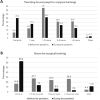Transforming ophthalmic education into virtual learning during COVID-19 pandemic: a global perspective
- PMID: 32651545
- PMCID: PMC7348577
- DOI: 10.1038/s41433-020-1080-0
Transforming ophthalmic education into virtual learning during COVID-19 pandemic: a global perspective
Abstract
Objective: The coronavirus disease 2019 (COVID-19) pandemic has imposed measures of social distancing and barriers in delivery of "in person" education. Institutions, involved in training the next generation of ophthalmologists, are using alternative teaching methods to maintain the standard of education.
Methods: We conducted a worldwide survey among physicians, who are actively involved in Ophthalmology-related education, between 3 and 14 April 2020. The expert survey, developed on the basis of literature search and focus group discussions, comprised 23 questions addressing the use of e-learning in Ophthalmology during the COVID-19 pandemic.
Results: A total of 321 participants from both academic and non-academic institutions worldwide, with variable practice experience and expertise, completed the survey. Before the pandemic, the majority of participants used traditional training modalities, including lectures, grand rounds and journal clubs, and 48% did not use any e-learning. There was a statistically significant increase in the use of all e-learning alternatives during the pandemic (p < 0.001), associated mainly with the availability of e-learning facilities (p < 0.001) and the academic character of institutions (p < 0.001). Zoom® was recognized as the mostly used platform for virtual teaching. Although theoretical teaching may take place, the surgical training of residents/fellows was dramatically reduced. The latter was significantly associated with participants' perspectives about teaching practices (p < 0.001).
Conclusion: COVID-19 pandemic imposed great challenges in the educational field of Ophthalmology. The experience related to virtual training in Ophthalmology, gained during the pandemic, may change the traditional teaching practices in the world and provide new educational opportunities.
Conflict of interest statement
Irini Chatziralli reports grants and personal fees from Allergan and Novartis, personal fees from Innovis and grants from Thea Laboratories, outside the submitted work. Anat Loewenstein reports grants and personal fees from Allergan, Bayer and Novartis, grants from Multicentre Trial and Sensor and personal fees from Notal-Vision, Syneos Health, Beyeonics, Roche, Oxurion, Oculis, Pres-By, Xbran, WebMD and KHB, outside the submitted work. All other authors have nothing to disclose.
Figures
Comment in
-
Comment on: Transforming ophthalmic education into virtual learning during COVID-19 pandemic: a global perspective.Eye (Lond). 2021 Sep;35(9):2648-2650. doi: 10.1038/s41433-020-01182-6. Epub 2020 Sep 14. Eye (Lond). 2021. PMID: 32929182 Free PMC article. No abstract available.
-
Active e-learning in ophthalmology through live webinars: back to the theatre.Eye (Lond). 2021 Nov;35(11):3159-3160. doi: 10.1038/s41433-020-01239-6. Epub 2020 Oct 28. Eye (Lond). 2021. PMID: 33116262 Free PMC article. No abstract available.
-
Overcoming barriers in access to ophthalmic education with virtual learning.Eye (Lond). 2022 Jan;36(1):237-238. doi: 10.1038/s41433-020-01337-5. Epub 2020 Dec 15. Eye (Lond). 2022. PMID: 33323989 Free PMC article. No abstract available.
References
MeSH terms
LinkOut - more resources
Full Text Sources
Medical
Miscellaneous





